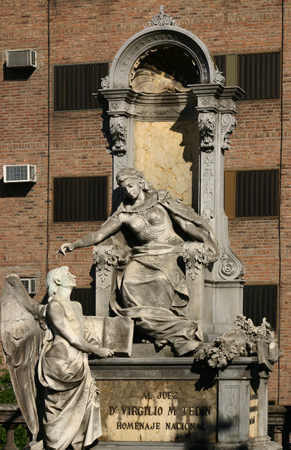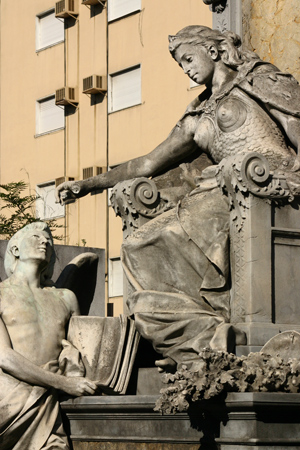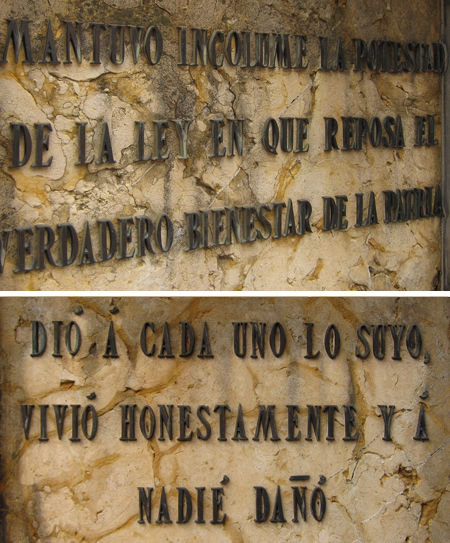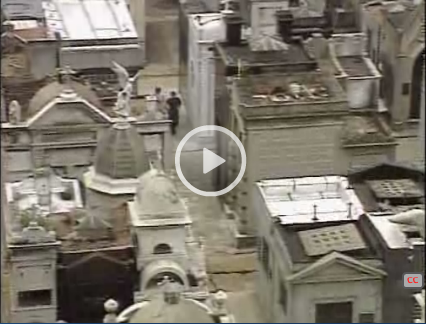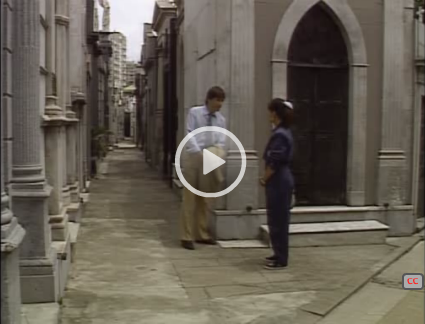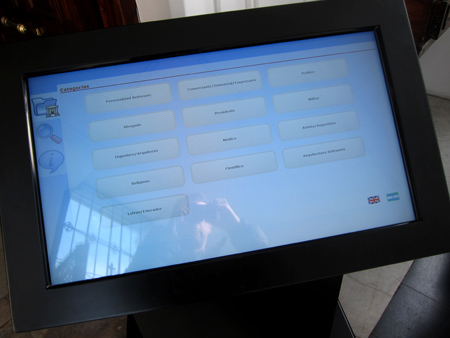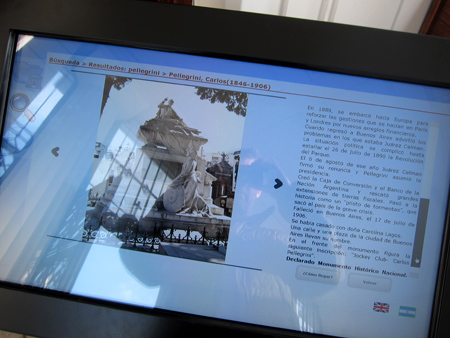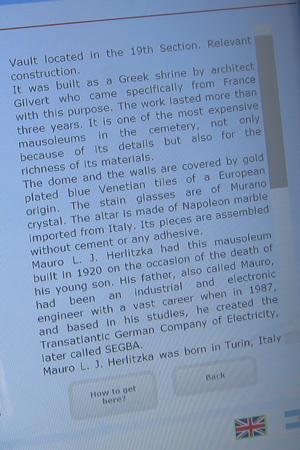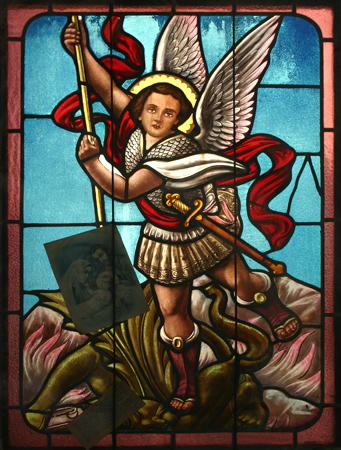It’s been awhile since an article about Recoleta Cemetery has been published in a US newspaper… tourism to Buenos Aires isn’t what it used to be. Not sure exactly who picked up the story, but it was run in July in the Miami Herald & in the Chicago Tribune:
Surprises in the Buenos Aires’ Recoleta Cemetery
by Marjie Lambert
Our visit to Recoleta Cemetery was going to be short. We were going to find Eva Duarte Peron’s tomb and leave. We were not admirers, just curious U.S. tourists. But before what turned out to be a long visit had ended, we had been drawn in like so many others.
With its elaborate architecture representing styles from Art Deco and Art Nouveau to Baroque and Neo-Gothic – plus its free admission – the cemetery is a popular attraction, drawing more than half a million people a year. One of the city’s biggest open-air arts and crafts markets sets up just outside the gates. By late afternoon, street musicians perform, and vendors sell snacks by the white-columned entrance.
At least 18 Argentine presidents are buried among the 4,691 crypts, as are hundreds of other politicians, military leaders, writers, actors, athletes and others once prominent in Argentine society. Yet the mausoleum where Evita is entombed is by far the most popular site on the 14-acre grounds, which is still an active cemetery. Sixty years after her death, people – many, like my friend and me, who hadn’t even been born yet when she died – still bring flowers to lay at the door of the modest Duarte family mausoleum.
The former first lady was a charismatic figure in her lifetime. In death, part of the mystique is the 24-year journey that her corpse took before arriving here. Her body was moved around Argentina the first few years after her death in 1952; then after her husband, Juan Peron, was overthrown as president, the military confiscated it and secretly sent it to be buried in Italy under a false name. Many years later, it was returned to Juan Peron, who by then was in exile in Madrid. He returned it to Argentina before his own death in 1974. Finally, in 1976, she was buried in a concrete vault 27 feet underground beneath layers of steel, in the mausoleum of her father’s family at Recoleta. Juan Peron is buried in another cemetery.
I had no interest in the rest of the cemetery. But that was before I stepped between the Greek columns at the entrance to el Cementerio de Recoleta, before I saw the elaborate mausoleums laid out in a neat grid, like miniature apartment buildings on tiny streets.
I was captivated. I had never been in a cemetery with mausoleums like these before, had never seen rows and rows of these narrow miniature stone buildings, some four or five stories tall, each different, topped with gilded domes or obelisks or steeples that looked like huge sorcerers’ hats, marked by ornate carvings and statuary, plaques, laurel wreaths fashioned from bronze, guarded by angels or birds with enormous wing spans. There were statues of nymphs, cherubs, babies, generals in uniforms and a bare-chested boxer in his robe.
We knew from looking at the big map by the entrance to the cemetery that the Duarte mausoleum was on the left side, about a third of the way back. But we gravitated to the wide “street” that ran up the center, where the oldest and most ostentatious mausoleums were. We wandered from one to the next, reading family names and recognizing some from Buenos Aires landmarks and street signs, becoming increasingly absorbed.
Here were, in addition to the many Argentine politicians and generals, the tombs of actress Zully Morena; poet Oliverio Girondo; Victoria Ocampo, a writer and the first woman admitted to the Argentine Academy of Letters; Luis Federico Leloir, Nobel-winning biochemist; and Armando Bo, actor and film director. A life-size replica of boxer Luis “Firpo” Angel, “the wild bull of the Pampas,” in his robe, stands outside his tomb.
We kept wandering and gaping, turning down alleys that were perfectly perpendicular to the main aisle, always knowing approximately where we were in relation to the Duarte mausoleum.
We marveled at mausoleums of dull concrete, white marble and shiny black granite, looked in through glass doors webbed with fancy ironwork, saw altars of fine Italian marble. Then, as we talked about the grandeur of the architecture and sculpture, we would come across broken glass or doors barely held together by rusted padlocks and see coffins strung with cobwebs and dusty silk flowers, a reminder that this was a place of death.
The further we got from the entrance, the fewer people we encountered. We barely noticed, but the back boundaries of the cemetery were not squared off, and the alleys were increasingly skewed. Finally we realized that we could no longer tell east from south.
The mausoleums rose on either side of us, creating canyons just high enough to block our view of landmarks. Around us was silence; we were no longer within earshot of the other visitors. We were lost in el cementerio.
I had assumed that we could find Evita’s tomb without even looking at a map, that we would recognize it by the presence of a crowd, much like the way a sudden traffic jam in Yellowstone National Park tells you where someone has spotted a bear, or at least a moose. We hadn’t counted on the canyon effect.
Finally we came upon a wide cross street and spotted people milling about, some distance away. We joined the small crowd of people, determined that they were in line to visit Evita’s tomb down a narrow side street, and went to the back of the queue. One man there held back. “You’re not in line?” I asked. He said he was waiting for his wife. “You see one tomb, you’ve seen them all,” he answered.
About 30 people who apparently disagreed with him were ahead of us, but the line moved quickly. At one point, two people squeezed past us, going to the front of the line. A woman’s Spanish-accented English cut through the crowd noise: “We are all waiting in line here.” The two people looked around, shrugged, and walked back the way they came.
The Duarte mausoleum was modest compared to many others. Fashioned in Art Deco style, the crypt had no sculptures, but a bronze door elaborately crafted with flowers, a large cross and ornate plaques on both sides. A few carnations and roses, wilted by now, had been stuck in the door or laid at its base.
None of the people in this group lingered long. They paused for a few seconds, perhaps took a photo, and moved on. Having turned our in-and-out visit to Evita’s tomb into a 2-hour exploration of architecture, sculpture and Argentine history – and having once again gotten our bearings in the “city of the dead” – so did we.
—
GOING TO RECOLETA CEMETERY
Recoleta Cemetery, Calle Junan 1790, at Plaza Francesa, is open daily from 8 a.m. to 6 p.m. Admission is free.
—————————
Links are not original to the article… added them in case someone wants more info. A couple of corrections: Juan Perón did not bring Eva back to Argentina. That was left to Isabel. And Eva’s tomb was built after Art Deco… but that’s no big deal. However, it’s Plaza “Francia,” the cemetery opens at 07:00 & the street name is Junín.
